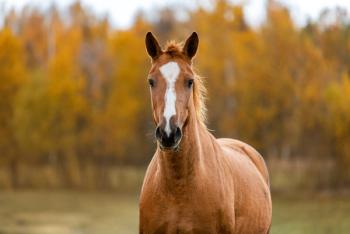
Diagnosing and treating the neonatal foal
Dysphagia in the neonatal foal manifests itself as the presence of milk in the foal's nares after nursing. Milk reflux in a foal should not be ignored. Aspiration pneumonia is the usual secondary consequence.
Dysphagia in the neonatal foal manifests itself as the presence of milk in the foal's nares after nursing. Milk reflux in a foal should not be ignored. Aspiration pneumonia is the usual secondary consequence.
Foals with mild dysphagia can appear normal at birth except for the presence of milk at the nose. As aspiration pneumonia develops, wheezes and crackles may be heard on auscultation of the lungs. A rattle in the trachea from the aspirated milk often can be felt after the foal suckles. If obstruction of the upper airways occurs as part of the dysphagia, stridor, heightened upper respiratory noise and increased inspiratory effort can be prominent clinical signs (Table 1).
Table 1: Causes of upper airway dysfunction in foals categorized by presenting sign of stridor
Differential diagnosis for dysphagia
The differential diagnoses for dysphagia in the foal are many and can include: dorsal displacement of the soft palate, rostral displacement of the palatopharyngeal arch, cleft palate, subepiglottic and pharyngeal cysts, bilateral laryngeal paralysis and arytenoid chondritis.
In a study of 38 foals with milk regurgitation/upper airway problems, 34 percent presented with dorsal displacement of the soft palate (DDSP). DDSP can be seen alone or in conjunction with rostral displacement of palatopharyngeal arch, redundancy of the soft palate or a persistent epiglottal frenulum. Prematurity, perinatal asphyxia and white muscle disease (nutritional myodegeneration, NMD) can be risk factors for the development of DDSP. In a review of 29 cases of NMD in foals, 52 percent of the foals presented with dysphagia as one of the clinical signs. Cerebral or brain stem disease may also influence the ability to swallow.
Unlike in humans where orofacial clefts, congenital fissures in the median line of the palate, are a common birth defect, cleft palate in the foal is very rare. The heritability of the cleft palate in the horse is unknown. The milk regurgitation is noted during the first nursing bout.
Subepiglottic and dorsal pharyngeal cysts also can interfere with the swallowing mechanism in the foal and cause upper-airway obstruction. These cysts are thought to originate from the thyroglossal and craniopharyngeal ducts, respectively.
Bilateral laryngeal paralysis and arytenoid chondritis have also been recognized in the newborn foal. Clinically these foals presented with respiratory distress. Laryngeal paralysis has been associated with cerebral diseases, such as congenital hydrocephalus. Arytenoid chondritis appears as an enlargement of the arytenoid cartilage and may mimic laryngeal paralysis.
Diagnostic Tests
Upper-airway endoscopy is the most rewarding diagnostic test for finding the origin of the milk regurgitation. It is best performed with manual restraint of the foal because sedation might affect the findings. A 1-meter, 1-1.5 cm diameter endoscope can be passed easily in a foal less than 40 kg. Milk in the trachea is evidence that aspiration is occurring.
Figure 1: Endoscopic view of a foal with DDSP. Note the displacement of the soft palate over the epiglottis and the mild rostral displacement of the palatopharyngeal arch (Equine Neonatal Medicine: A Case Based Approach, Spring 2006, Elsevier).
DDSP is readily apparent on endoscopic examination if there are no other abnormalities. The normal triangular shaped epiglottis is hidden under the soft palate (Figure 1). When DDSP is accompanied by other abnormalities, such as rostral displacement of palatopharyngeal arch and collapse of the walls of the pharynx, it can be difficult to orient oneself to the larynx. In small foals, such as miniatures, the presence of an endoscope in the nares actually can create enough rostral obstruction to increase negative pressure in the pharynx and artificially displace the soft palate during scoping. In these cases, a lateral radiograph of the throatlatch of the head often will be diagnostic of DDSP. In DDSP, the free edge of the soft palate can be seen on the radiographs (Figure 2).
Figure 2: Lateral radiograph of the pharyngeal region of a foal with DDSP. Note the free edge of the soft palate is visible over the tip of the epiglottis (Equine Neonatal Medicine: A Case Based Approach, Spring 2006, Elsevier).
In a complete cleft palate, involving the hard and soft palate, one can observe it on a simple oral examination. If the cleft involves the caudal hard palate and soft palate then use of endoscopy or a long-bladed laryngoscope is necessary for the diagnosis.
Pharyngeal and subepiglottic cysts seen with the endoscope appear as fluid-filled masses and can also obscure the epiglottis from view. Upper respiratory distress can prevent a safe endoscopic examination of these foals until a tracheotomy is performed.
Paralysis of the larynx and arytenoid chondritis can be seen endoscopically as lack of movement of the arytenoids. In arytenoid chondritis, the arytenoids appear swollen and inflamed.
Radiography is the best diagnostic for determining the extent of the aspiration pneumonia. A heavy interstitial to alveolar pattern in the caudal ventral lung field is found in milk aspiration.
DVM Newsbreak
A minimum database consisting of IgG levels, a CBC, a chemistry profile and an arterial blood gas analysis is important in these foals. Decreased IgG levels and abnormalities in the CBC may indicate a concurrent sepsis as a cause of generalized weakness. The chemistry profile abnormalities may be suggestive of muscle disease. An arterial blood gas analysis is helpful in directing specific oxygen therapy.
Treatment
Treatment of milk aspiration in foals focuses on the immediate cessation of aspiration, the provision of nutrition to the foal, antibiotic therapy to eliminate any bacterial infection and eliminating the cause of the dysphagia.
It is essential to prevent the foal from nursing. This is done most easily by muzzling the foal. An alternative to muzzling would be to separate the foal from the mare but because this condition is often temporary, orphaning the foal should be a last resort.
Suggested Reading
Nutrition can be provided to the foal through an indwelling nasogastric tube. Foals eat approximately 25-30 percent of their body weight (BW kg). A 45-kg foal eating 30 percent of its BW would need 13.5 liters of milk, divided into two to four feedings during a 24-hour period.
Occasionally a foal will not tolerate the presence of a nasogastric tube and will hypersalivate — continuing to aspirate saliva into the lungs. Total parenteral nutrition may be an option. Placement of esophagotomy tube, bypassing the oropharynx, might be a less-expensive alternative of providing nutrition.
Antibiotic therapy should provide broad-spectrum coverage. Generally, an aminoglycoside for gram-negative coverage plus a beta lactam or a cephalosporin for gram-positive coverage is adequate. One can expect a mixed bacterial component due to the non-sterile nature of the aspirated milk.
In cases where there is severe stridor and upper airway obstruction, an emergency tracheotomy might be necessary. This might need to be done before you have made your diagnosis. This is most likely to be seen in foals with pharyngeal cysts, arytenoiditis, bilateral paralysis of the arytenoids and severe pharyngeal collapse.
As discussed earlier, etiology of DDSP in the neonatal foal has been attributed to redundant soft-palate tissue, persistent epiglottic frenulum, prematurity, perinatal asphyxia and NMD. Many times, no etiology can be found. Surgical approaches have been recommended in the cases of redundant soft palate and persistent epiglottic frenulum, but with rest and supportive care, many foals with simple DDSP will resolve in two to four days on their own. Subsequently, it is probably prudent to treat medically first. If the pharyngeal muscular weakness is secondary to prematurity or perinatal asphyxia, then treatment of the primary problems is important.
Specific treatment for NMD is the administration of a vitamin E/Se supplement (E-Se®) by intramuscular injection (1 ml/45 kg). This can be repeated in three and eight days. Foals should be confined to the stall and all physical exertion minimized. Dill reports that foals that survive, regain strength and the ability to swallow gradually of two to six days.
In the case of pharyngeal cysts, surgical removal has been performed through a laryngotomy or pharyngotomy approach. Transendoscopic laser surgery has also been successful and perhaps less traumatic than traditional surgical approaches. For immediate relief of the airway obstruction involved in the dorsal pharyngeal cyst, one can use an endoscopic biopsy instrument to puncture and drain the cyst.
Surgical repair can be attempted for the correction of cleft palates in the foal. It is difficult to obtain adequate visualization without a mandibular symphysiotomy. Complications include dehiscence of the repair, chronic nasal discharge stunted growth and osteomyelitis of the mandibular symphysis.
Outcome
Foals with milk aspiration do surprising well. In a survey of 38 foals with upper airway problems/aspiration pneumonia, 82 percent recovered or improved with medical care and support. Those that were euthanized had the following diagnoses: bilateral laryngeal paralysis, bilateral arytenoiditis, septic pneumonia and congenital heart defect. A study on the long-term outcome of surviving foals has not been done. Anecdotal reports have been favorable but athletic performance has not been evaluated.
Mary Rose Paradis, DVM, MS, Dipl. ACVIM (LAIM) has been a professor in the Tufts Cummings School of Veterinary Medicine since 1983. She is director of the Marilyn Simpson Neonatal Intensive Care Program, associate professor Department of Clinical Sciences, primary investigator for the Dorothy Havemeyer Foundation since 1990 and chair of the Board of Regents of the ACVIM in 2005-2006. Her major clinical interests include equine neonatal intensive care, equine geriatrics and internal medicine. She is a frequent contributor to veterinary publications and editor of new Equine Neonatal Medicine: A Case Based Approach, to be released this Spring by Elsevier.
Newsletter
From exam room tips to practice management insights, get trusted veterinary news delivered straight to your inbox—subscribe to dvm360.




